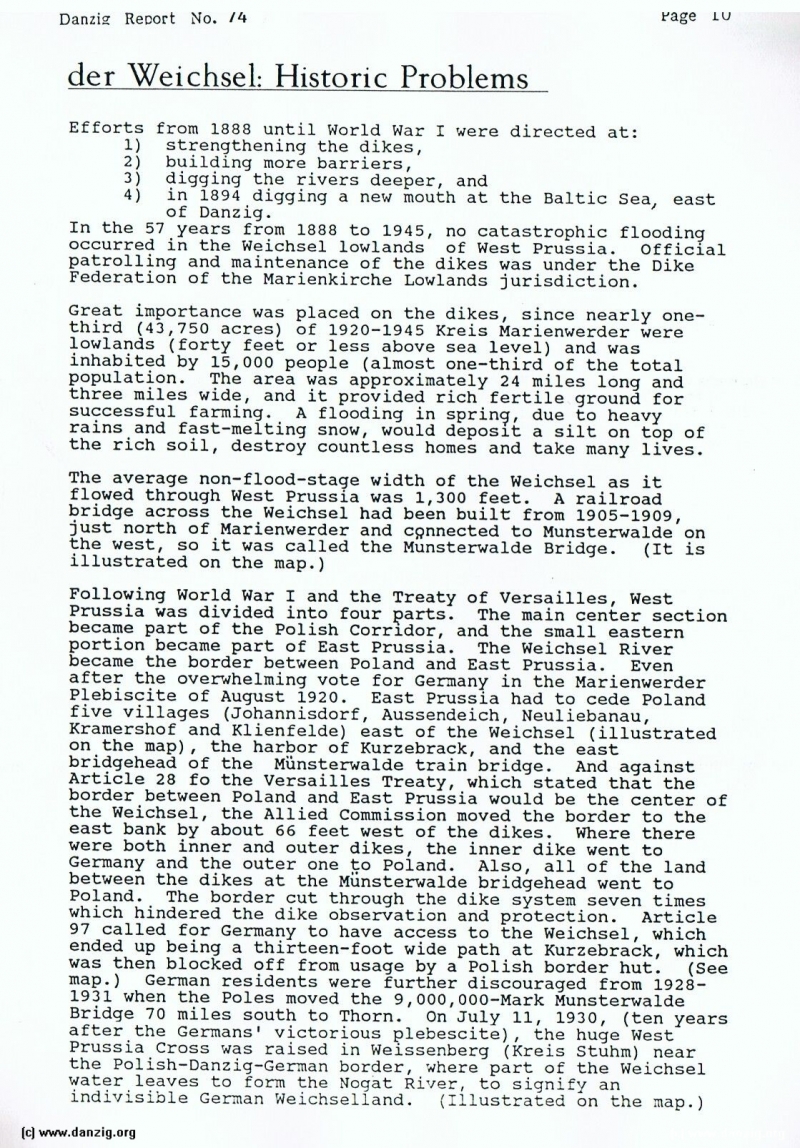
der Weichsel: Historic Problems
Efforts from 1888 until World War I were directed at:
1) strengthening the dikes,
2) building more barriers,
3) digging the rivers deeper, and
4) in 1894 digging a new mouth at the Baltic Sea, east of Danzig.
In the 57 years from 1888 to 1945, no catastrophic floodinc occurred in the Weichsel lowlands of West Prussia. Official patrolling and maintenance of the dikes was under the Dike Federation of the Marienkirche Lowlands jurisdiction.
Great importance was placed on the dikes, since nearly one— third (43,750 acres) of 1920—1945 Kreis Marienwerder were lowlands (forty feet or less above sea level) and was inhabited by 15,000 people (almost one—third of the total population. The area was approximately 24 miles long and three miles wide, and it provided rich fertile ground for successful farming. A flooding in spring, due to heavy rains and fast-melting snow, would deposit a silt on top of the rich soil, destroy countless homes and take many lives.
The average non-f 1ood-stae width of the Weichsel as it flowed through West Prussia was 1,300 feet. A railroad bridge across the Weichsel had been built from 1905—1909, just north of Marienwerder and cpnnected to Munsterwalde on the west, so it was called the Munsterwalde Bridge. (It is illustrated on the map.)
Following World War I and the Treaty of Versailles, West Prussia was divided into four parts. The main center section became part of the Polish Corridor, and the small eastern portion became part of East Prussia. The Weichsel River became the border between Poland and East Prussia. Even after the overwhelming vote for Germany in the Marienwerder Plebiscite of August 1920. East Prussia had to cede Poland five villages (Johannisdorf, Aussendeich, Neuliebanau, Kramershof and Klienfelde) east of the Weichsej. (illustrated on the map), the harbor of Kurzebrack, and the east bridgehead of the Münsterwalde train bridge. And against Article 28 fo the Versailles Treaty, which stated that the border between Poland and East Prussia would be the center of the Weichsel, the Allied Commission moved the border to the east bank by about 66 feet west of the dikes. Where there were both inner and outer dikes, the inner dike went to Germany and the outer one 1o Poland. Also, all of the land between the dikes at the Munsterwalde bridgehead went to Poland. The border cut through the dike system seven times which hindered the dike observation and protection. Article 97 called for Germany to have access to the Weichsel, which ended up being a thirteen-foot wide path at Kurzebrack, which was then blocked of f from usage by a Polish border hut. (See map.) German residents were further discouraged from 1928- 1931 when the Poles moved the 9,000,000—Mark Munsterwalde Bridge 70 miles south to Thorn. On July 11, 1930, (ten years after the Germans’ victorious plebescite), the huge West Prussia Cross was raised in Weissenberg (Kreis Stuhm) near the Polish—Danzig-German border, where part of the Weichsel water leaves to form the Nogat River, to signify an indivisible German Weichselland. (Illustrated on the map.)
Danzig Report Nr. 74 - January - February - March - 1992, Page 10.
Hits: 3679
Added: 01/07/2015
Copyright: 2025 Danzig.org

